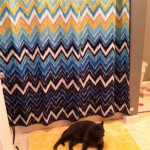Flame Retardant Curtains For Classrooms: Ensuring Safety and Compliance
Classrooms, being environments where numerous individuals congregate for extended periods, necessitate stringent adherence to safety regulations. Among the various safety measures, the incorporation of flame retardant curtains stands out as a crucial element in mitigating fire hazards. These curtains, specially treated to resist ignition and slow the spread of flames, offer a vital layer of protection for students, teachers, and the overall school infrastructure. This article will explore the significance, benefits, types, regulations, and considerations involved in selecting and maintaining flame retardant curtains for classrooms.
The Importance of Flame Retardant Curtains in Educational Settings
The presence of flammable materials in classrooms, such as paper, furniture, and decorations, contributes to a potential fire risk. A fire can rapidly escalate, posing a significant threat to life and property. Flame retardant curtains serve as a proactive safety measure by inhibiting the spread of flames, providing valuable time for evacuation and minimizing potential damage. Their importance stems from several key factors:
Protecting Occupants: In the event of a fire, flame retardant curtains can significantly delay the spread of flames, providing crucial time for evacuation. A fire's rapid progression can quickly overwhelm occupants, hindering their ability to escape safely. By containing the initial blaze, these curtains increase the chances of a successful and orderly evacuation.
Minimizing Property Damage: Fires can cause extensive damage to school buildings, resulting in costly repairs and disruptions to educational activities. Flame retardant curtains help to limit the fire's spread, thus minimizing the extent of property damage. This can significantly reduce the financial burden associated with fire restoration and allow for a quicker return to normalcy following an incident.
Meeting Regulatory Requirements: Fire safety regulations, often mandated by local and national authorities, frequently stipulate the use of flame retardant materials in public spaces, including classrooms. Compliance with these regulations is not only a legal obligation but also a crucial step in ensuring the safety of the school community. Using flame retardant curtains helps schools meet these requirements and demonstrate their commitment to safety.
Enhancing Overall Safety Culture: The implementation of flame retardant curtains contributes to a broader safety culture within the school environment. It demonstrates a proactive approach to risk management and fosters a sense of security among students, teachers, and staff. This heightened awareness can encourage individuals to be more vigilant about fire safety practices and contribute to creating a safer environment for everyone.
Types of Flame Retardant Curtains
Flame retardant curtains are manufactured using various techniques and materials to achieve fire resistance. Understanding the different types available is essential for selecting the most appropriate option for a specific classroom environment. The primary categories include:
Inherently Flame Retardant (IFR) Fabrics: These fabrics are woven from fibers that are naturally flame resistant. The flame retardant properties are inherent to the fiber itself, meaning they will not wash out or diminish over time. Examples of IFR fabrics include modacrylic, Trevira CS polyester, and some inherently flame retardant blends. IFR fabrics tend to be the preferred choice for long-term fire safety solutions, as their flame retardancy is permanent.
Durably Flame Retardant (DFR) Fabrics: DFR fabrics are treated with a flame retardant chemical finish during the manufacturing process. This treatment is designed to withstand multiple washings and maintain its effectiveness over time. While DFR fabrics offer good fire resistance, the flame retardant finish may eventually degrade with repeated laundering or exposure to certain environmental conditions. Regular testing and re-treatment may be required to ensure continued compliance with safety standards.
Topically Treated Fabrics: These fabrics are sprayed or coated with a flame retardant chemical solution after the fabric has been woven. This is a less expensive method compared to IFR and DFR treatments but typically offers the least durable flame resistance. Topically treated fabrics are more susceptible to losing their flame retardant properties through washing or wear and tear. They may be suitable for temporary applications but are generally not recommended for long-term use in classrooms due to their reduced durability.
Blackout Flame Retardant Curtains: These curtains combine the benefits of flame retardancy with light-blocking capabilities. They are ideal for classrooms where it is necessary to control the amount of sunlight entering the room, such as during presentations or for students with light sensitivity. Blackout curtains typically consist of multiple layers of fabric, including a flame retardant layer and a light-blocking layer.
Regulations and Standards for Flame Retardant Curtains
The use of flame retardant curtains in classrooms is governed by various regulations and standards designed to ensure their effectiveness and compliance with safety requirements. These regulations vary depending on the location, but they generally address the following aspects:
National Fire Protection Association (NFPA): The NFPA develops and publishes codes and standards related to fire safety. NFPA 701, "Standard Methods of Fire Tests for Flame Propagation of Textiles and Films," is a widely recognized standard for testing the flame resistance of textiles, including curtains. This standard outlines the testing procedures and performance criteria that flame retardant curtains must meet to be considered compliant.
International Fire Code (IFC): The IFC is a model code that provides minimum requirements for fire prevention and life safety. It is adopted by many jurisdictions in the United States and internationally. The IFC specifies the types of materials that are permitted in buildings and outlines the requirements for flame retardant treatments.
Local Building Codes: Local building codes often incorporate or reference national standards and codes, such as NFPA 701 and the IFC. These codes may also include additional requirements specific to the local jurisdiction. It is essential to consult with local building officials to determine the specific regulations that apply to flame retardant curtains in classrooms.
Testing and Certification: Flame retardant curtains should be tested and certified by an independent testing laboratory to ensure they meet the applicable standards and regulations. Look for certifications from organizations such as Underwriters Laboratories (UL) or Intertek. These certifications provide assurance that the curtains have been rigorously tested and meet the required performance criteria.
Documentation and Labeling: Flame retardant curtains should be clearly labeled to indicate their flame retardant properties and the standards they meet. This labeling should include the manufacturer's name, the fabric composition, and the relevant test standards. It is important to maintain documentation of the testing and certification for future reference.
Beyond these primary regulations, schools should also consider accessibility guidelines, such as those outlined in the Americans with Disabilities Act (ADA), when selecting and installing curtains. The curtains should not obstruct pathways or create hazards for individuals with disabilities.
The responsibility for ensuring compliance with these regulations typically falls on the school administration or the facilities management department. Regular inspections and maintenance of the curtains are also crucial to ensure their continued effectiveness.
Selection and Maintenance Considerations
Choosing and maintaining flame retardant curtains effectively involves several crucial considerations, from initial selection to ongoing care. These considerations ensure the curtains provide the necessary fire protection and maintain their integrity over time.
Fabric Selection: The choice of fabric is paramount. IFR fabrics, while potentially more expensive initially, offer the most reliable and long-lasting flame retardant properties. DFR fabrics are a viable alternative, but their flame retardancy should be regularly assessed, especially after washing. Avoid topically treated fabrics for long-term classroom use.
Weight and Opacity: Consider the weight and opacity of the fabric in relation to the classroom's needs. Heavier fabrics offer better light control and insulation, while lighter fabrics may be more suitable for aesthetics or ease of movement. Blackout curtains are optimal for rooms requiring complete darkness.
Color and Design: While safety is the primary concern, the color and design of the curtains should also be considered to complement the classroom's aesthetics. Choose colors and patterns that are conducive to a learning environment and that won't distract students.
Hardware and Installation: The hardware used to hang the curtains should be sturdy and fire-resistant. Ensure the curtains are properly installed to prevent them from falling or obstructing exits in the event of a fire. Consider using breakaway hardware that allows the curtains to detach easily if necessary.
Cleaning and Maintenance: Follow the manufacturer's instructions for cleaning and maintaining the curtains. Avoid using harsh chemicals or excessive heat, as these can damage the flame retardant treatment. Regularly inspect the curtains for signs of wear and tear, and repair or replace them as needed.
Regular Testing: For DFR fabrics, periodic testing by a qualified laboratory is recommended to ensure the flame retardant treatment remains effective. The frequency of testing will depend on the manufacturer's recommendations and the level of use the curtains receive. Maintain records of all testing and maintenance activities.
Professional Cleaning Services: Consider using professional cleaning services that specialize in cleaning flame retardant fabrics. These services have the expertise and equipment to clean the curtains without compromising their fire-resistant properties.
Replacement Schedule: Even with proper care, flame retardant curtains will eventually need to be replaced. Establish a replacement schedule based on the type of fabric, the frequency of use, and the manufacturer's recommendations. This will ensure that the classroom always has adequate fire protection.
By diligently following these selection and maintenance guidelines, schools can ensure that their flame retardant curtains provide a safe and effective barrier against fire hazards, protecting students, teachers, and the entire school community.

Curtains Making Services

Flame Retardant Curtains For Safety Twopages

Fireproof Fire Retardant Bamboo Satin Shading Curtain Fabric For Classroom And Polyester Made In China Com

Flame Retardant Curtain For School Fire Resistant Blackout Curtains Grommet Wind

Best Fire Resistant Classroom Decor Ideas And Alternatives

Red Inhe Flame Retardant Blackout Curtains Drape For Bedroom 6 Silver Grommet Begoodtex

Dimgray Permanent Fire Resistant Blackout Curtains Drape For School 6 Silver Grommet Begoodtex

School Curtains Flame Retardant Library Df Blog Direct Fabrics

Grey Room Darkening Inhe Flame Retardant Curtains Rod Pocket Meet Nfpa70

Antibacterial And Flame Retardant Disposable Hospital Curtains








